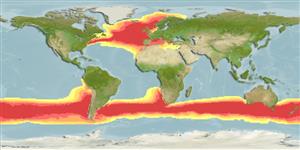Classification / Names
Common names from other countries
Main reference
Size / Weight / Age
Max length : 350 cm TL male/unsexed; (Ref. 4645); common length : 244 cm TL male/unsexed; (Ref. 5951); max. published weight: 230.0 kg (Ref. 40637); max. reported age: 30 years (Ref. 247)
Length at first maturity
Lm 175.0, range 170 - 180 cm
Environment
Marine; pelagic-oceanic; oceanodromous (Ref. 51243); depth range 0 - 715 m (Ref. 26346)
Climate / Range
Temperate; 1°C - 18°C (Ref. 6871), preferred 17°C (Ref. 107945); 76°N - 59°S, 180°W - 180°E (Ref. 247)
Distribution
Circumglobal, amphitemperature with centers of distribution in the North Atlantic and temperate water of the southern hemisphere; not in equatorial seas. Appendix III (Mediterranean) of the Bern Convention (2002). Appendix II of the Bonn Convention (2009).
Countries | FAO areas | Ecosystems | Occurrences | Introductions
Short description
Dorsal
spines
(total): 0;
Dorsal
soft rays
(total): 0;
Anal
spines: 0;
Anal
soft rays: 0. A stout, spindle-shaped shark with large black eyes, a sharp, conical snout, long gill slits, and small, smooth-edged, narrow teeth with side cusps (Ref. 5578, 88171). Strong keels on the caudal peduncle, short secondary keels on the caudal base, and a crescentic caudal fin; the insertion of the small second dorsal fin is above the insertion of the anal fin (Ref. 88171). Dark grey dorsally, white ventrally, without blotches (Ref. 6581, 43278); rear tip of 1st dorsal abruptly white (Ref. 5578).
IUCN Red List Status (Ref. 115185)
Threat to humans
Traumatogenic (Ref. 4690)
Human uses
Fisheries: commercial; gamefish: yes
Tools
Special reports
Download XML
Internet sources
Estimates of some properties based on models
Phylogenetic diversity index
PD50 = 0.7813 many relatives (e.g. carps) 0.5 - 2.0 few relatives (e.g. lungfishes)
Trophic Level
4.6 ±0.0 se; Based on diet studies.
Resilience
Very Low, minimum population doubling time more than 14 years (K=0.12; tm=5; tmax=30; Fec=1-5)
Vulnerability
Very high vulnerability (86 of 100)
Price category
